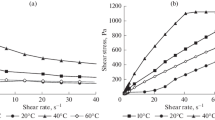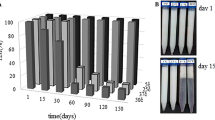Abstract
Margarines from the rheological point of view are thixotropic plastic semisolids that change their plastic character with changes in the portions of the fat and aqueous phases. Contrary to lard and shortening, the emulsions containing ca. 85 and 15% of the fat and aqueous phases, respectively, follow the Casson equation (similarly as butter), whereas those containing 40 and 60%, respectively, satisfy the Herschel-Bulkley equation, which affects remarkably the way of evaluating experimental data. A new precise, and objective rheometrical method was developed for evaluating flow properties, which enables one to check quality and stability of margarines over a wide temperature interval just in the course of their production, and this may be helpful during the optimization of technology processes and standardization of product quality.
Similar content being viewed by others
References
Sherman, P., “Industrial Rheology,” Academic Press, London and New York, 1970, p. 83.
Shama, F., and P. Sherman, J. Texture Stud. 1:196 (1970).
Søltoft, P., “On the Consistency of Mixtures of Hardened Fats,” Lewis, London, England, 1947, p. 4.
Smidt, A.A., K.G. Savilova, E.S. Ermolova, L.M. Ratchenko, and I.B. Czekmarova, Masio-Zhir. Prom. 37:15 (1971).
Sone, T., “Consistency of Foodstuffs,” Reidel Publ. Co., Dordrecht, The Netherlands, 1972, p. 114.
Muller, H.G., “An Introduction to Food Rheology,” Heinemann, London, England, 1973, p. 88.
Naudet, M., “Rheological Methods Applied to Margarines,” Rev. fse Corps gras — N° spéc. 1969 sur “La Margarine,” 1969, p. 99.
Van Wazer, J.R., J.W. Lyons, K.Y. Kim, and R.E. Colwell, “Viscosity and Flow Measurement,” Interscience, New York, NY, 1966, p. 14.
Barry, B.W., and B. Warburton, J. Soc. Cosmetic Chem. 19:725 (1968).
Casson, N., in “Rheology of Disperse Systems,” Edited by C.C. Mill, Pergamon Press, London, England, 1959, p. 84.
Herschel, W.H., and R. Bulkley, Kolloid-Z. 39:291 (1926).
Stern, P., J. Cmolik, and E. Mares, Preceedings of the 13th Conference on the Technology and Analysis of Fats, Organized by the Czechoslovak Chemical Society, Liblice, 1974.
Davis, S.S., J. Texture Stud. 4:15 (1973).
Haighton, A.J., JAOCS 36:345 (1959).
Author information
Authors and Affiliations
About this article
Cite this article
Stern, P., Cmolik, J. Study of rheological properties of margarine. J Am Oil Chem Soc 53, 644–647 (1976). https://doi.org/10.1007/BF02586280
Received:
Issue Date:
DOI: https://doi.org/10.1007/BF02586280




